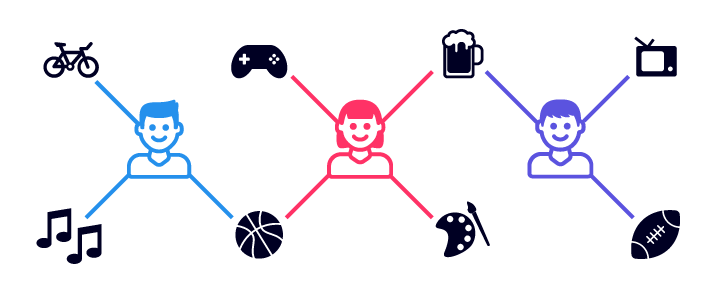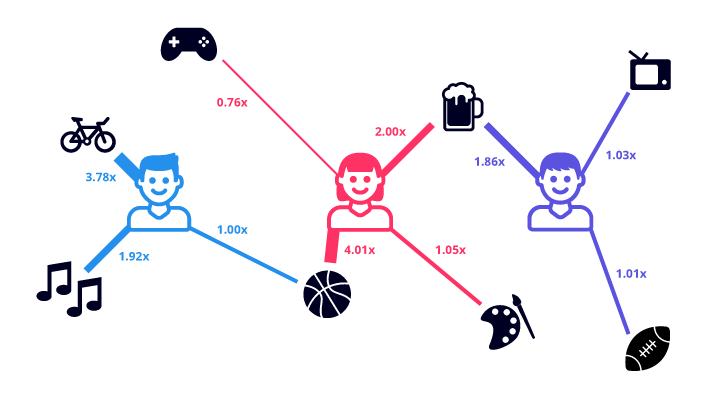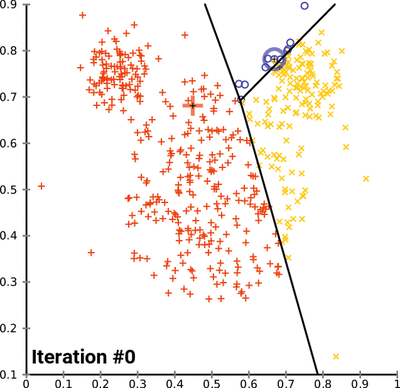Your audience is constantly growing and changing — as is the world it inhabits.
But when you take a traditional approach to audience segmentation, each study represents a relatively narrow view at a specific moment in time.
Luckily, advances in machine learning and artificial intelligence have allowed companies like Helixa to automate the process of audience segmentation. What used to take weeks now spans only a few minutes, so you can repeat it easily and move on to competitors and partners.
I spoke with our lead machine learning engineer, Luc Mioulet, to learn more about the benefits of machine learning for audience segmentation. He also shared the process we use at Helixa.
If you’re ready to dig deeper and understand what your audience really cares about, let’s get started.
Machine learning offers a path to more lucrative segmentation
The only true way to validate a specific audience segmentation analysis as “successful” is to use it in the market and see if it leaves you calculating your profits or heading back at the drawing board.
However, strengthening your methodology increases your chances of developing highly relevant segments that produce tangible results. One way to do this is by introducing machine learning, which can process greater volumes of data and connect those dots more precisely.

When you use machine learning to segment your audience:
-
- The analysis goes much deeper: Even if you were somehow able to gather millions of people to match our panel and convince them to rank their interest in each of our hundreds of categories, you wouldn’t be able to process the data across all of those dimensions. Sadly, human evolution stalled out in 3-D.
-
- There is less room for confirmation bias: Because traditional segmentation is limited by time and resources, researchers tend to start with the segmentation axes that confirm or deny their hypotheses. Machine learning takes that constraint out of the picture, demonstrating the strongest patterns — including the ones you weren’t expecting.
-
- The results come back much faster: A traditional segmentation study can take weeks of planning, surveys, and analysis. Our segmentation analysis returns results in minutes. Then, you can run it again, and again, for different variations on the audience. Use what you learned to iterate and discover new insights.
By leveraging machine learning in audience segmentation, you arrive at a faster, stronger process that delivers unexpected insights.
A little birdy told us what your audience really cares about
At Helixa, our customers can define an almost infinite number of audiences within our platform. Instead of understanding just one audience, our algorithms must account for the vast range of items that any of those different audiences may engage with.

SOURCE: Helixa Inc
Observed online behavior from Twitter’s API is the best source that checks all our boxes: The dataset is publicly available, it fires off the right signals for our purposes, and it’s massive enough to be both versatile and statistically significant.
“All of the things we engage with on Twitter, and the ways we engage, are a reflection of who we are and what makes us tick,” Mioulet said, “probably even more than self-reported survey data, which can be prone to response biases.”
On Twitter, you can like, reply to, and retweet posts and tag and follow accounts. All of these actions demonstrate a different level of interest and engagement, and they are all recorded in the API as distinct actions. Taken together, these millions of actions can then be used to score our panel’s depth of engagement with specific accounts.

SOURCE: Helixa Inc
For example, if you’re a passionate home chef, you’re probably:
-
- Engaging with your favorite chefs and food bloggers
- Favoriting and retweeting your favorite recipes from food outlets
- Following the brands that make your favorite tools and ingredients
The sum of these actions would indicate a high level of passion in our platform, and the three accounts you are following to get started with your new mountain biking hobby would indicate a lower level of interest.
“Twitter, like most social media networks, is an echo chamber,” Mioulet shared. “We follow things we already agree with and care about. Perhaps that is not great for discourse, but it’s excellent for market research and psychographic segmentation.”
Overall, Helixa recognizes more than 60,000 items. New additions arrive every week, as trending topics rise from obscurity at light speed.
“Twitter is the ideal dataset for the kinds of analyses we run at Helixa,” Mioulet said. “When you look at these actions, it forms a graph that models the ways we are all connected on the platform.”
“That graph is always shifting,” he added, “and we’re able to capture those changes.”
Helixa’s three-step segmentation process does the heavy lifting for you
At Helixa, we design our clustering algorithms to meet the needs of our clients. Those needs create three major constraints that guide both our algorithms and the overall process.
Our clustering algorithms need to:
-
- Work on small and mid-sized segmentations: Our customers are trying to segment well-defined audiences, not an entire country.
-
- Return accurate results: Luckily, machine learning provides the mathematical framework to check this box with a high degree of confidence.
-
- Work quickly: Our clients have come to rely on getting their results in minutes. At Helixa, we must always weigh potential improvements against the speed of the analysis.
We accomplish this through a three-step process, which I’ve broken down below.
Here’s how it all works.
1. Importing and processing the initial data
After each update of our data, we extract and categorize the relevant information for each audience profile to make the dataset more actionable.
This includes cleaning up any detected bot or outlier behavior within the panel using statistical methods that maintain the data distribution.
2. Preprocessing the aggregated data
In the Helixa platform, our customers build queries to define their audiences. Queries are built from a combination of demographics, psychographics, and offline consumption data provided through our partnership with MRI-Simmons.
Once they have defined their audience, they can analyze and segment it. At this point, the segmentation tool preprocesses the data to prepare it for the clustering algorithms.
As mentioned earlier, humans are limited to three dimensions of visualization, but the machine learning algorithms can see as many dimensions as there are categories. Not all audiences are equal, and not all are active in the same categories, so an automated feature selection process removes any irrelevant data.
“To provide the optimal input for the clustering algorithm, we loosely compact similar data points in the context of our various categories,” Mioulet explained. “That way, the clustering can be done in a fast and efficient way, without losing any information.”
3. Running the cluster analysis
Finally, the clustering algorithms create the actual segments, determining the ideal amount of segments. The possibilities are then analyzed and the properties of each one are assessed to provide quality scores.

Helixa will automatically pick the best segmentation, but you can easily and quickly explore other options with varying numbers of segments, without leaving the platform.
“We use a scoring function that favors compact segments (where the panelists of a segment are closely related) that are well-separated from one another,” Mioulet explained.
“The best segmentation should provide the customer with a clear picture of how each segment is different from the rest,” he added.
Machine learning is the future of audience research
With the right inputs and a robust process for making sense of the data, machine learning provides a huge upgrade to the process of audience segmentation.
As a result, your personas could drive business decisions across the organization, instead of gathering dust in the marketing folder.
Plus, the results come back in minutes, so you can spend the rest of your time refining the audience — or exploring new ones, like those following your competitors and potential partners.
And clients are taking note: Rauxa told us our platform has contributed to “some of the most strategic work [they've] done to date,” and VMLY&R shared, “It would take multiple tools to replace the deeper insights [they] can uncover with Helixa.”
If you’re ready to see our platform in action, just schedule 15 minutes with us. It’s that fast.
One day soon, machine learning will be as commonplace in marketing as PPC ads are today. The question is: Do you want to apply it now, or do you want to give your competitors the head start?
 Ryan is the Marketing Communications Manager at Helixa, where he leads content strategy from the NYC office. He believes in a lot of things, but never ghosts, guilty pleasures, or his Florida Gators’ offense.
Ryan is the Marketing Communications Manager at Helixa, where he leads content strategy from the NYC office. He believes in a lot of things, but never ghosts, guilty pleasures, or his Florida Gators’ offense.




